Your browser does not fully support modern features. Please upgrade for a smoother experience.
Please note this is an old version of this entry, which may differ significantly from the current revision.
Subjects:
Others
Dynamic CCT lighting is proposed as a method to control sleep quality, and a novel hypnotic lighting system is developed according to the experimental design.
- dynamic light
- heart rate variability
- sleep quality
1. Development of Novel Hypnotic Lighting System
According to the research of Kathleen E. West et al. [21] and the results of CIE, Photobiology Safety Technical Manual, when the Correlated Color Temperature (CCT) exceeds 4000 K, it can significantly inhibit the secretion of melatonin in the human body, 4000 K. There is no obvious inhibition in the following [21], and the human eye has a significant inhibition of melatonin in the 460–480 nm band of blue light and achieves the peak effect [22]. In this study, the design of light source parameters refers to the past research results of our team [23,24,25] to design the dynamic lighting as the experimental light source.
Therefore, this experiment designed three light environments for sleep experiments. The three experimental light sources all use our self-designed novel hypnotic lighting system to simulate the required light sources. Figure 1 is the control and correction flow chart of the novel hypnotic lighting system control and correction. The first light environment has a dark room, and no lights are turned on in a completely dark environment. The second is Dynamic CCT lighting, which changes back and forth from CCT 1900 K to 3800 K, as shown in Figure 2 and Figure 3. The third light environment is Dim light, referring to the light source parameters of night lights on the market, the CCT is 1900 K, as shown in the light source spectrum in Figure 4.
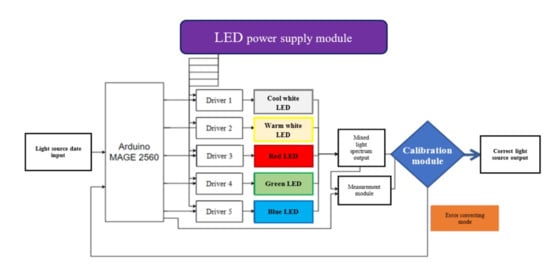
Figure 1. Flow chart of novel hypnotic lighting system control and correction. This technology consists of RGB LEDs and two cool and warm white LEDs to form a multi-spectrum dynamic light supply system. It has a measurement and correction system that can monitor and control the spectrum, illuminance, CCT, color rendering and Duv.(driver: led power driver, led drive power supply; cool white LED CCT: 6000 K ± 100 K. warm white LED CCT: 3300 K ± 100 K).
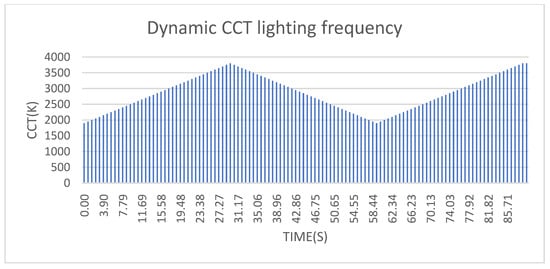
Figure 2. This is the changing frequency of Dynamic CCT lighting, which is changed by 50 K (CCT) each time, rising from the lowest CCT 1900 K to the highest CCT 3800 K (for example: 1900 K, 1950 K, 2000 K, 2050 K, 2100 K,…, 3800 K), and then Descending from 3800 K to 1900 K every 50 K (e.g., 3800 K, 3750 K, 3700 K, 3650 K,…, 1900 K) in one cycle and complete within one minute, then repeat.

Figure 3. (a) Lowest Dynamic CCT lighting spectrum (1900 K); (b)The highest Dynamic CCT lighting spectrum (3800 K), please refer to Figure 2 for the Dynamic CCT lighting frequency.
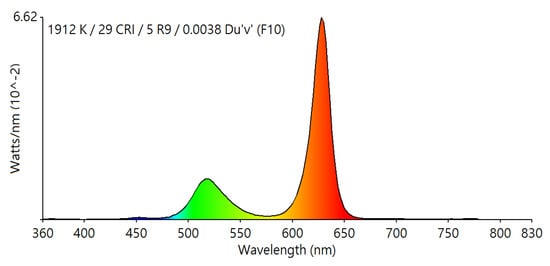
Figure 4. Dim light spectrum, which is the same as the lowest Dynamic CCT lighting spectrum (1900 K), is designed according to the night light spectrum.
2. The Effect of Different Sleeping Environment on Heart Rate Variability
As mentioned in the preceding paragraph, the rising parasympathetic activities (nHFP) mean that the volunteers are in a relaxed state. When analyzing sympathetic activities (nLFP), due to the interference of parasympathetic activities, they cannot be directly used as sympathetic activities to indicate that it is in a state of excitement and wakefulness. For this reason, it is necessary to compare the balances of autonomic nervous activity (LF/HF) with each other. If there is a statistically identical difference between nLFP and LH/HF, it means that their sympathetic activities are consistent at this time. When both of them increase at the same time, it means that they are emotionally high and sober. Declining data mean that a person wants to relax and sleep.
Under three different light sources of sleep environment, the statistical results of HRV show that under Dynamic CCT lighting sleep, the mood of the volunteers is relaxed, and the nHFP of the whole short-term sleep is rising, which represents that the volunteers having N2 and N3 stages of sleep. In nLFP and LH/HF, in the first 15 min, Dynamic CCT lighting and dark room results are similar, both of them showing the downward trend and appearing statistically different. Furthermore, parasympathetic activities are improved, which is significantly better than Dim light, indicating that the volunteers could quickly enter the sleep stage. However, after 15 min, there is no significant statistical difference, and nLFP and LF/HF results are not consistent, which could not explain the sympathetic activities. Dynamic CCT is therefore used. The sleep quality of lighting is higher than that of dark room and Dim light.
3. Volunteers and Non-volunteers Correlation
In the volunteersive psychological questionnaire, there are significant differences in the statistical results of sleep quality and better spirit after sleep. Using Dynamic CCT lighting in the sleep environment is better than Dim light, compared with dark room, although there is no statistical difference; the average value is still higher than dark room. The results show that Dynamic CCT lighting is better than Dim light and better than dark room in sleep. In ESS questionnaire, there is no significant difference among the three sleep light environments.
From the results of the volunteersive psychological questionnaire and non-volunteersive physical signal measurement, it can be found that the relaxation state of Dynamic CCT lighting is better than that of dark room and also better than that of Dim light. In volunteersive psychological mode, Dynamic CCT lighting is superior to dark room and Dim light in terms of lighting. In the questionnaire analysis, the volunteersive view is that Dynamic CCT lighting is better than dark room and better than Dim light, showing a positive correlation among the above data, indicating that the use of Dynamic CCT lighting can really make the volunteers have a good sleep effect.
4. The Transformation of Dynamic Hypnotic Light
It can be seen from the above results that, in terms of the fixed light source, dynamic lighting has more significant physiological stimulation, even a dark room is the best sleeping environment, but dynamic lighting is still effective in helping the volunteers fall asleep and gain better work concentration. With the work content in the workplace becoming more and more extensive, more energy and physical strength is needed to complete these matters, and the novel hypnotic lighting system developed by this research institute is also needed. According to the research of Omer Sharon and Yuval NIR in 2018, with the help of specific frequency of dynamic lighting, the response of slow-wave activities (SWA) of brain is particularly significant [1]; through the research results of Lynn (2015), we can also see that the improvement of slow-wave activities can help achieve better sleep quality and improve work quality and concentration after a short rest [20].
From the analysis result of heart rate variability, Dynamic CCT lighting enhances nHFP, comparing with dim light and dark room, with statistical differences. It reveals that the novel hypnotic lighting system could help volunteers more efficiently relax the mood. The assistance of Dynamic CCT lighting in getting to sleep and the sleep quality is consistent with the nHFP result (Figure 5 and Figure 6), showing the improvement of the volunteerss’ sleep efficiency and quality with Dynamic CCT lighting. It can be prov-en by the decrease in typing error and the increase in typing efficiency (Figure 7) that volunteerss, after effective short rest, actually enhance work efficiency and concentration.
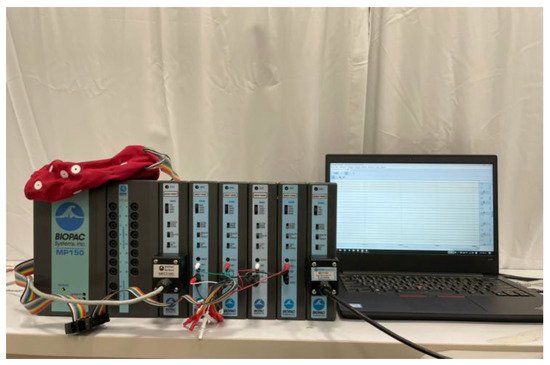
Figure 5. MP-150 (Bipac system) physiological signal measuring instrument: connect to a computer via a local area network (LAN), and you can connect to different physiological signal amplifiers by yourself. The sampling frequency can be as high as 200 Hz. The signal processed by the amplifier is very weak, so it needs to be amplified (1 Mv × 1000 times = 1 V) before it is easy to record and analyze the signal clearly.
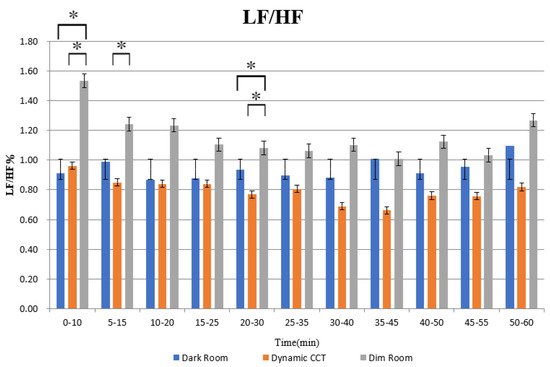
Figure 6. Dark room, Dynamic CCT and Dim light effect comparison chart on LF/HF under sleep environment. “*” is p < 0.05.
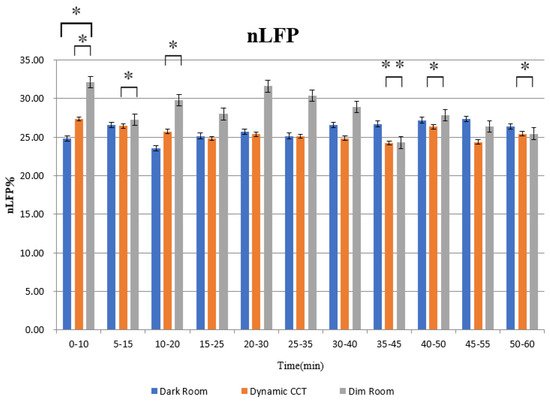
Figure 7. Dark room, Dynamic CCT and Dim light effect comparison chart on nLFP under sleep environment. “*” is p < 0.05, “**” is p < 0.005.
This entry is adapted from the peer-reviewed paper 10.3390/app12052284
This entry is offline, you can click here to edit this entry!
